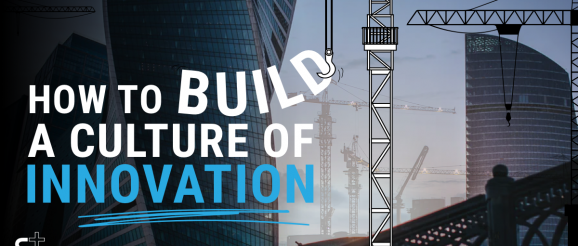How to Build A Culture of Innovation

Imagine sitting on a seesaw unaccompanied – you wouldn’t get very far. Some things (at TST, we’d argue most things) are best shared. And it’s just the same here. ‘Innovation is not a solo sport’ says Hal B Gregersen, co-author of ‘The Innovator’s DNA’.
So, in a world where innovation is king, how can you make sure it’s multi-player and touches every aspect of your Early Talent’s journey?
It’s an age-old fallacy that you’re just born with some skills, but we disagree. It’s easy to attribute innovation to natural talent, or even an ‘Aha Moment’ like the apple that fell on Newton’s head. What if a culture of innovation could be built? What can you as a leader do to equip your team of innovation players to be winners at the sport? What skills should you be fostering to develop a creative environment where ideas can fuse for success? Here’s how we do it:
1. Get Colliding
Think of the environments we inhabit, each with its own sort of innovations: the scale of the internet, the differentiators of each coffee shop, biological environments like the coral reef, the development and evolution of the first cities – each of these shows innovation, but what do they have in common?
Studies have shown that what all of these incredible creations have in common is the patterns; each example demonstrates a network of interrelated components that together generate innovation. The more opportunities we have to collide ideas together, the more innovative we can be.
Innovation is evidently not just a single entity, but complex ecosystem of associations and ideas fusing together to solve a problem. This pattern-making is a physical reaction in your brain too: your brain sends signals that are quite literally creating new combinations inside your head – so how do we increase the likelihood of these collisions to enable innovative thinking in Early Talent? Make sure your networks and associations are vast and interconnected.
‘Innovation is not a solo sport’ says Hal B Gregersen, co-author of ‘The Innovator’s DNA’.
2. Observe, Observe, Observe
It’s not all about those random ‘Eureka Moments’ – ideas rarely just come to you. One way these ‘Aha Moments’ can be encouraged, enhanced and increased is through observation. Waiting for an epiphany to suddenly solve the problem will not foster the right environment for innovation to flourish; instead, we must take steps to develop our approaches and practice the skills that allow innovation to develop. Observation is one such skill. By simply observing the world around us, we can make new associations and connections that facilitate innovation.
In the 1600s, Galileo Galilei observed that the swinging of a chandelier, regardless of the angle it swung, remained constant – something he timed using his pulse to confirm. He theorized that this swinging pendulum motion could be used to create more precise timepieces, and his theory proved true. Even though he never built one in his lifetime, the pendulum is a fairly reliable measure of time.
By observing this phenomenon and forming a theory around it, Galileo created the bedrock for more innovation to follow. The point? Get observing. By collecting data through observation and measurement, your brains can feedback solutions and innovations. Observation is key to understanding problem areas, and as a result, opening the door for innovative solutions.
3. Stop. Collaborate.
With of employees believing that people in their own organisations don’t collaborate enough, think how innovative businesses could become if everyone understood how to collaborate for innovation.
One particular investigation, led by Harvard professor Linda A. Hill, found that those magical ‘Aha Moments’ are best accomplished through cooperation. Professor Hill studied a diverse group of global leaders of innovation from different industries to discover where their secret to innovation resides. The study concluded that it is ‘collective genius’ that lies behind their successes. She suggests that there are three things we need to do to facilitate collaborative innovation:
#1 Be abrasive – create constructive arguments, with active listening where individuals advocate their point of view. Here, conflict is necessary to create a portfolio of ideas.
#2 Be agile – the ability to test and refine a portfolio of ideas; discovery driven by learning. It’s a series of experiments, not pilots.
#3 Be resolution-focused – you must combine ideas to find an effective solution, regardless of position, leaving egos outside of the room to focus on the team effort.
4. Level The Playing Field
One of Professor Hill’s best examples of complete commitment to innovation comes from observing Pixar, the animation studio. Professor Hill attributes Pixar’s success to its iterative and “messy” processes that remove barriers of rank. In a Pixar ideation, everyone’s ideas are welcome, and hierarchy and egos are left at the door. Pixar’s processes are full of little details that make a big difference to their success, allowing them to produce the magical cinematic experiences of ‘Toy Story’ and ‘Up’.
In his book Creativity Inc, Ed Catmull, president of Pixar and Disney Animation Studios, recalls his realisation that even the shape of their meeting room table impacted on their ideation process, purely because it facilitated hierarchical organisation and failed to create an environment where all levels could participate. Now Pixar never meet around a boardroom-style table; it’s all about the round table, and no more place names by rank. Of course, there will be false steps and multiple perspectives in the room, but with candour and resilience, innovation can come out on top.
So, if innovation can be considered a team sport, then we should all start paying more attention to how we’re practicing. Get colliding, observe more, and collaborate. Fuse networks together and think about the little details. How are you facilitating collaboration to encourage innovation? How are you conducting meetings?
If you’re still sat around a long boardroom table, it might be time to re-evaluate.
The post How to Build A Culture of Innovation appeared first on The Smarty Train.

